Mastering Tree Felling Techniques: A Guide to Different Undercuts
- December 8, 2023
- 0 comment
Tree felling is a critical skill in forestry and arboriculture requiring precision, an understanding of tree physics, and safety considerations. The method of cutting, particularly the type of undercut, significantly influences the direction and manner in which a tree falls. A recent YouTube video titled “How Trees Fall With Different Undercuts” provides an insightful demonstration of various tree-felling techniques. This article delves into these techniques, highlighting their unique characteristics and applications.
The Basics of Undercuts
An undercut is a fundamental aspect of tree felling, serving as the initial cut made in the tree during the felling process. This cut is not just the first step in bringing a tree down; it’s a strategic move that significantly influences the direction in which the tree will fall. The primary purpose of an undercut is to create a controlled path for the tree’s descent, ensuring both the safety of the feller and the protection of the surrounding environment.
The undercut plays a crucial role in tree felling for several reasons:
- By determining the direction of the tree’s fall, the undercut minimizes the risk of the tree falling in an unintended direction, which could lead to property damage or personal injury.
- It acts as a safety mechanism, allowing the person felling the tree to have a degree of control over a potentially dangerous process.
- The undercut relieves some of the stress and tension in the tree, making the subsequent back cut easier and safer.
7 Different Types of Undercuts in Tree Felling
1. Very High Back Cut and Uneven Notch
The Very High Back Cut and Uneven Notch technique is a sophisticated method used in tree felling for situations demanding high precision in the direction of the tree’s fall. This approach involves making a back cut higher up on the tree and creating an uneven notch at the front. It is particularly effective for trees with irregular shapes or significant leans. The higher backcut alters the tree’s center of gravity, providing more control over the fall, while the uneven notch guides the tree more precisely in the desired direction. This technique is invaluable in urban areas or near structures where precision is paramount.
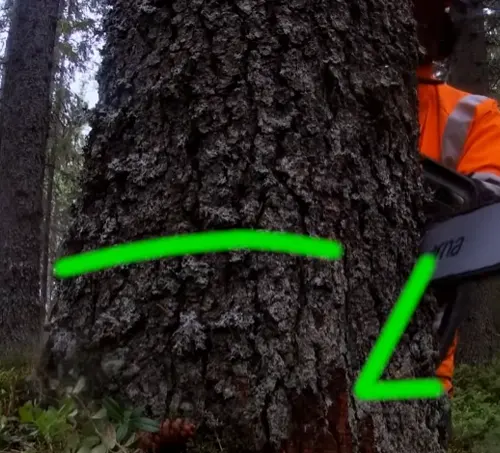
2. Shallow Notch
The Shallow Notch technique is characterized by removing less wood from the tree, resulting in a shallower cut. This method is advantageous in situations where space is limited or when the tree is naturally aligned to fall in a straight line. By making a shallower notch, the tree feller can ensure a more controlled and predictable fall, especially in confined spaces. This technique is less invasive and can be particularly useful in residential areas or when working close to other trees or structures.
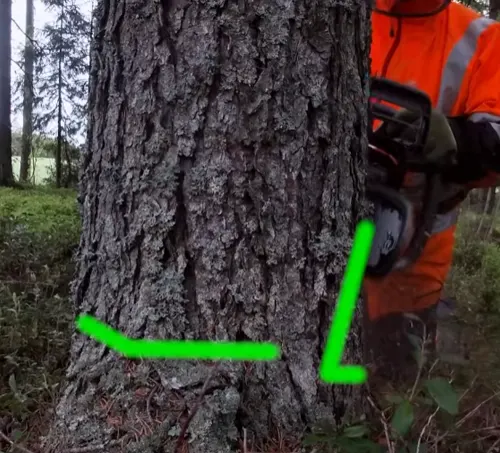
3. Thick Hinge
Creating a Thick Hinge involves leaving a substantial amount of wood at the hinge point during the felling process. This technique is designed to slow down the tree’s fall, thereby providing the feller with greater control over the descent. It is especially useful in dense forests or in proximity to buildings and other structures where a slow, controlled fall is necessary to avoid damage. The thick hinge acts as a buffer, reducing the tree’s momentum as it falls.
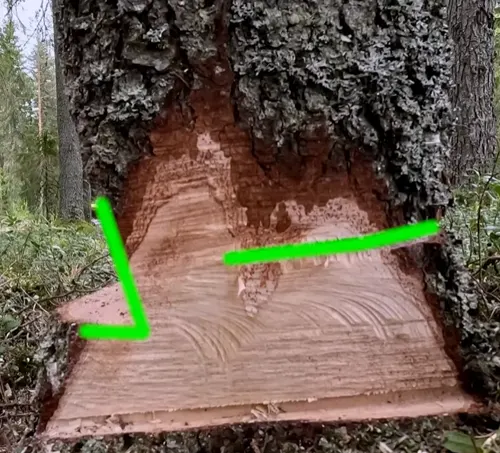
4. Shallow Notch and Thick Hinge
The combination of a Shallow Notch and a Thick Hinge is a strategic approach used in challenging felling environments. This method merges the benefits of both techniques, offering enhanced control and precision. The shallow notch ensures that the tree does not pivot too aggressively, while the thick hinge slows the fall, allowing for a more measured and controlled descent. This technique is particularly effective in uneven terrains or in areas where other trees or structures could be impacted by the fall.
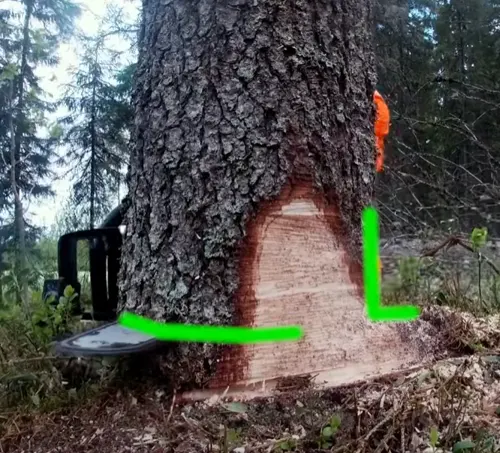
5. The Conventional Method
The Conventional Method is the most widely used technique in tree felling. It involves making a standard notch at a conventional depth and angle. This method is versatile and suitable for a wide range of trees, particularly those of average size and in standard felling conditions. It provides a good balance between control and ease of execution, making it a go-to choice for many professional tree fellers.
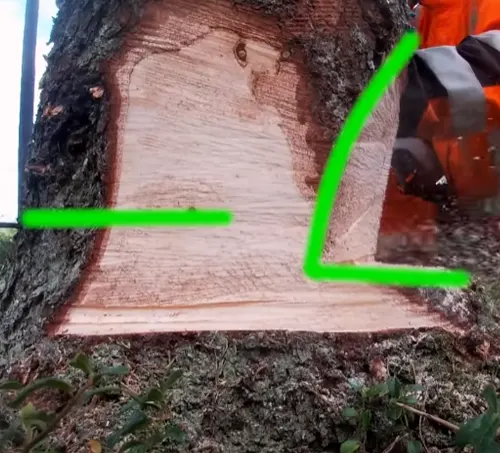
6. Very Shallow Notch
The Very Shallow Notch technique is employed when minimal movement of the tree is desired during the fall. This method is particularly useful for trees that are already leaning significantly in the desired direction of fall. By making a very shallow notch, the tree feller can utilize the tree’s natural lean to guide its descent with minimal additional force or direction needed. This technique is often used in sensitive environments where the surrounding area needs to be preserved.
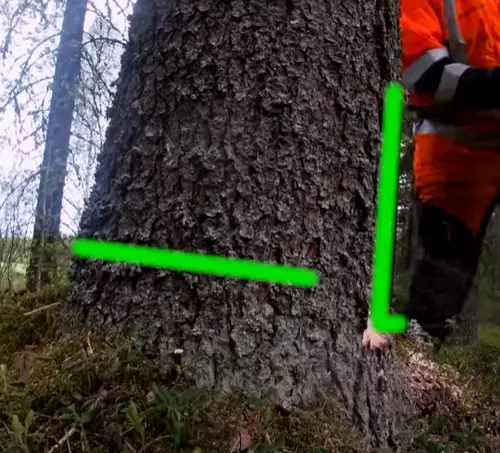
7. Low Back Cut
The Low Back Cut technique involves making the back cut lower than usual. This method affects the leverage and speed of the tree’s fall and is often used for larger trees or in situations where specific lean issues need to be addressed. By cutting lower on the trunk, the feller can manipulate the falling process, providing more control over how the tree descends. This technique is particularly useful in managing trees with complex leans or in areas where precision is crucial to avoid damage to nearby structures or vegetation.
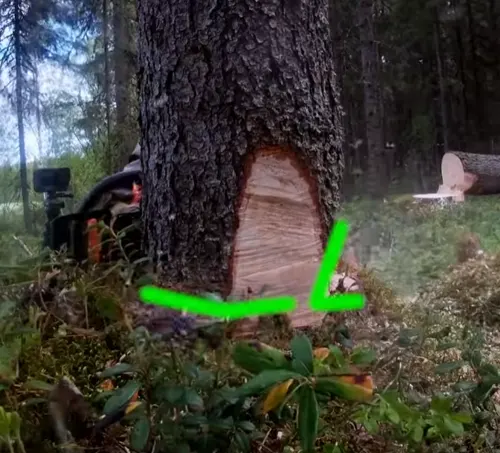
Environmental Impact Discussion
Tree felling, while a necessary practice in forestry and arboriculture, has significant environmental implications. Sustainable tree-felling practices are crucial to minimize the impact on ecosystems. Responsible felling involves considering the habitat of wildlife, preserving the biodiversity of the area, and ensuring that the removal of trees does not lead to soil erosion or water cycle disruption. It’s also important to consider the carbon footprint of tree removal and the role trees play in carbon sequestration. In sustainable forestry, tree felling is often balanced with replanting initiatives to maintain ecological balance. Understanding these environmental factors is essential for anyone involved in tree felling, emphasizing the need for careful planning and execution.
Safety Protocols
Safety is paramount in tree felling, given the inherent risks involved. Adhering to detailed safety guidelines is essential:
- Always wear appropriate PPE, including a hard hat, safety goggles, ear protection, gloves, and steel-toed boots.
- Ensure the chainsaw is in good working condition, with a sharp chain and full fuel and oil levels. Familiarize yourself with the chainsaw’s safety features.
- Before felling, assess the area for hazards like overhead lines, uneven terrain, or nearby structures.
- Plan and clear two escape routes opposite the direction of the tree’s intended fall.
- Maintain clear communication with any assistants or bystanders, ensuring they are at a safe distance.
- Have a first aid kit readily available and be trained in basic first aid and CPR.
Tool and Equipment Recommendations
The right tools and equipment are crucial for effective and safe tree felling:
- A powerful, well-maintained chainsaw with a bar length appropriate for the tree size. For larger trees, a chainsaw with at least a 20-inch bar is recommended.
- High-quality PPE, including a helmet with face shield, hearing protection, Kevlar chaps, and anti-vibration gloves.
- Essential for directing the fall of the tree and preventing the saw from getting pinched.
- For larger or more complex jobs, especially in tree climbing and sectional felling.
Training and Certification Information
Professional training and certification are crucial for anyone pursuing tree felling:
- Many countries have professional associations that offer training courses and certifications in tree felling and arboriculture.
- Some vocational or technical schools offer courses in forestry and tree felling.
- There are online courses available for basic knowledge, but hands-on training is essential for practical skills.
- Look for certification programs recognized by industry bodies, such as the International Society of Arboriculture (ISA) or similar organizations in your country.
- Consider apprenticeships or working under experienced arborists to gain practical, on-the-job training.
Incorporating these sections into your article will provide a more rounded and comprehensive guide, covering the environmental, safety, and educational aspects of tree felling.
Conclusion
Tree felling is indeed an intricate art that requires a blend of skill, deep knowledge, and a profound respect for nature. The insightful “How Trees Fall With Different Undercuts” video serves as a remarkable resource, shedding light on the nuanced techniques of tree felling. Whether you’re a seasoned professional arborist or a passionate forestry enthusiast, mastering these techniques is key to ensuring safe, efficient, and environmentally responsible tree felling.
If you find yourself particularly drawn to any of these undercut techniques, or if you have your own experiences and preferences in tree felling, feel free to share your insights and stories. The community of tree care professionals and enthusiasts is always enriched by the shared experiences and knowledge of its members. Your input could be invaluable to someone just starting out or looking to refine their skills.
Moreover, the tools and equipment used in these techniques are as important as the methods themselves. From the precision of a well-maintained chainsaw to the protection offered by high-quality safety gear, the right tools make all the difference. Sharing your recommendations or seeking advice on the best equipment can also be a great way to engage with the community.
We encourage you to explore further, whether through additional online resources, community workshops, or hands-on training sessions. There’s a wealth of knowledge to be discovered, and a community of like-minded individuals to connect with. Your journey in mastering these tree-felling techniques is not just about personal or professional growth, but also about contributing to sustainable forestry practices and the stewardship of our natural environment.
So, if you have a favorite undercut technique, a story about your experiences in tree felling, or tips on the best tools for the job, don’t hesitate to share. Your insights could inspire and educate others, fostering a community of informed, skilled, and environmentally conscious individuals. Together, we can continue to respect, learn from, and care for the natural world around us through the art and science of tree felling.
FAQs
- What is an undercut in tree felling, and why is it so important?
An undercut is the first cut made when felling a tree. It’s crucial because it determines the direction in which the tree will fall, ensuring control and safety during the felling process. - How do the Very High Back Cut and Uneven Notch techniques differ from traditional methods?
This technique involves a higher back cut and an uneven front notch, offering greater control for trees with irregular shapes or leans. It’s particularly useful in urban areas or near structures where precision is paramount. - Can the Shallow Notch technique be used for any tree size?
The Shallow Notch technique is best suited for smaller trees or in situations where the tree is expected to fall straight. It’s less effective for large trees or those with significant leans. - Why is a Thick Hinge left during some tree felling operations?
A Thick Hinge slows down the tree’s fall, providing more control. It’s especially useful in dense forests or near structures to prevent damage and ensure safety. - Is the Conventional Method suitable for beginners in tree felling?
Yes, the Conventional Method, involving a standard notch depth and angle, is suitable for beginners due to its simplicity and versatility. - When would you use a Very Shallow Notch, and what are its benefits?
A Very Shallow Notch is used when minimal tree movement is desired, such as when a tree is already leaning in the desired direction. It minimizes the force needed to fall the tree, reducing the risk of unexpected movements. - How does a Low Back Cut affect the tree’s fall compared to a High Back Cut?
A Low Back Cut lowers the pivot point, affecting leverage and slowing the fall, which is beneficial for larger trees or those with specific lean issues. - Are there any environmental considerations to keep in mind when choosing an undercut technique?
- Yes, the choice of undercut technique should consider the surrounding environment, including wildlife habitats, nearby vegetation, and overall ecosystem impact.
- What safety equipment is essential when performing different undercuts in tree felling?
Essential safety equipment includes a hard hat, safety glasses, ear protection, gloves, chainsaw chaps, and sturdy boots. The equipment may vary slightly depending on the complexity of the cut. - Can undercut techniques be combined for complex tree felling situations?
Yes, in complex situations, arborists may combine different undercut techniques to address specific challenges, such as combining a Shallow Notch with a Thick Hinge for controlled precision.

David Murray
Forestry AuthorI'm David Murry, a forestry equipment specialist with a focus on chainsaw operation. With over 13 years of experience, I've honed my skills in operating and maintaining a wide range of machinery, from chainsaws to log splitters. My passion for the outdoors and commitment to sustainable forestry drive my work, which emphasizes safety, efficiency, and staying updated with industry advancements. Additionally, I'm dedicated to sharing my expertise and promoting environmental awareness within the forestry community.





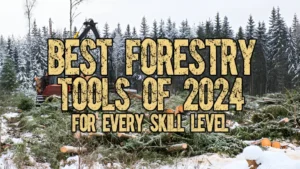







Leave your comment